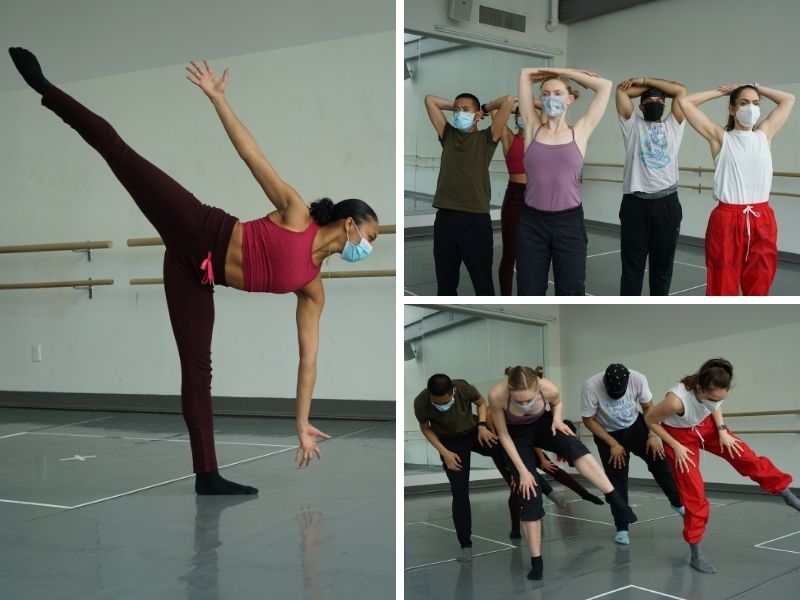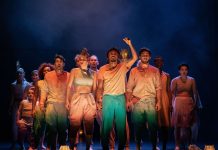Company | E put out a bold call for choreographers early this spring. In the era of COVID cancellations and livestream programming this announcement provided a bright spot, a hint that change was on the way with a certain return to in-person performances. Naturally I had a few questions for Company | E, and what better way to get an in-the-know answer than to divide the inquiries among directors, cast members, and designers.

Jane Franklin: Company | E has been working with themes of climate change for quite some time. What made you come back to this theme now?
Paul Gordon Emerson (executive director and co-artistic director): First, it’s essential to keep this topic at the forefront of our minds. The impacts of climate change are accelerating and the window of time to move positively and aggressively to mitigate them is narrowing. We can change, and it’s essential that we see that.
Second, we felt that a call for entries, largely from a next generation of choreographers, would yield equally fresh ideas — new ways of creating around these questions — ways that reflect the ideas, views, and concerns of artists who have grown up as climate impacts have been present and of critical concern to them and to their generation.
Third, we wanted a topic that would generate ideas from around the world. Climate change is boundaryless. Its impacts are global. But the manifestations of it are often specific to different geographies. We saw this as a way of bringing people together under a topic that concerns us all, and that would yield for our audiences and our artists unique insights into how people from places outside DC see this.
The outcome of that has been, for example, that Emese [Nagy], who is Hungarian, has created a work that is a very strong commentary on our obsession with consumption, and by way of this the astonishing amount of waste we generate that comes from things we don’t need. Our preoccupation with status is driving consumption, which, in turn, creates enormous ecological issues that are entirely unnecessary and within our power to change as individuals.
Can you tell us about the venue Company | E has chosen for this first in-person performance?
This is the first ticketed event at the new Fabian Barnes Theater at the Dance Institute of Washington [DIW]. We were intimately involved in the design and construction of the theater, and as a part of our work on it, and with DIW, we are, for lack of a better term, the first “tryout concert” in the theater in front of a live audience.
The Barnes was designed with their executive director, Kahina Haynes, to respond to the challenges of sustainability. That was true in terms of the materials we used and reused — and she repurposed materials at every opportunity — even though you would never know they were not new. The entire lighting system is state-of-the-art LED based, and that cuts power consumption over the old lighting system by orders of magnitude. It reduces heat load from the lighting, which cuts HVAC costs as well by orders of magnitude.
The new sound-damping panels are LEED certified. Very careful attention was given to making the Barnes footprint as small as possible in terms of resources used.
So on every front it made sense to be at the new Fabian Barnes Theater, especially for a show about climate.

The choreographers are from around the world. What was particularly unique about each choreographer, about their process of developing material and working with the Company | E artists? Did you find any similarities in their approaches?
Kathryn Sydell Pilkington (co-artistic director): There were several different levels of collaboration that occurred throughout the five different creation processes. While each choreographer had a very clearly developed idea of the work they ultimately wanted to create, some came with a specifically mapped-out plan on how to get there, and some started day one creating movement alongside the dancers based on what they were seeing. For example, Maddie [Hanson]’s work, CURRENT, is very much connected to the music and the projections. She had timed out different points in the score where she knew she wanted solo work, group work, and the overall rise and fall of the piece from the very beginning. Her unknowns at the start were the exact movement, and that’s where the dancers played a strong role. She created phrases with each of the dancer’s input, which is why you’ll see many thematic elements that are both group-oriented and solo work mixed together seamlessly. On the other hand, Ashley [Lobo] used the start of the process to get to know the dancers’ individual movements and strengths, and there was much more improvisation in his process. Across the board, however, each choreographer allowed a great amount of individual freedom to the dancers to find their own way of approaching the movement and work.
Can you provide details about the rehearsal process? We know that some rehearsals were online and some in-person. What did each format provide?
All of the rehearsal processes started the same way with the choreographers and dancers all working through Zoom. Once the material and phrase work was developed, the Company | E dancers were able to meet for in-person rehearsals where the structure, and in some cases partnering work, was introduced. We were fortunate to have a couple of the choreographers, Maddie and Robert [Rubama], who are both located in NYC, travel down for the last days of the in-person rehearsals. While there were certainly challenges, by the time we were into the last process with Rayven [Leak], the dancers were well-versed in the way they had been working throughout the spring, many of those early challenges were easy to solve quickly.
Tell us about the dancers. How do the Company | E artists contribute or what does each dancer bring to the process that is unique?
Kathryn Sydell Pilkington: This concert shows the best of the Company | E artists, through not only their beautiful dancing but also much of the creation. Each artist was willing to jump in to this different way of working wholeheartedly and with an open mind, and they excelled through the collaboration with each choreographer. You’ll see their individuality often throughout the evening through highlighted solo work, but the real treat is the group work that was achieved during the online portions of rehearsals.
Kelsey Rohr (company member): We bring so much of ourselves into each process — our dance styles, our personalities, our experiences. Depending on how much the choreographer asks for, we have done everything from choreograph or manipulate movement to showing up as ourselves inside the piece. I’ve even been asked to write and perform a short paragraph of my own words. This concert feels like it celebrates the people and voices in the company, and that is a testament to the choreographers’ ability to meet us where we are as people, not just as dancers.
Emese made sure to include Horizon [Miguel] and me in every step of her process. The smaller cast provided a sense of intimacy. She encouraged us to go farther and get sillier. She would tell Horizon and me to add noise to our movement, allowing for grunts, screeches, and laughter. I had the privilege of seeing Horizon in full funny mode. There are shimmies, multiple layers of clothing. and a story about needing cheese from New Zealand although lactose intolerant.
Gillian Clifford (company member): Most if not all of the choreographic processes we artists have been through have had a heavy emphasis on improvisation. Each one of the choreographers has had a vastly unique approach to creating on the Zoom platform, but every one has collaborated with us and encouraged us to voice our opinions, feelings, and input on the piece! In a way, each artist’s own personal touch has been implemented in every dance, and I think that’s what makes this show particularly wonderful.
As a new member of the company, I noticed coming in immediately that every dancer had a very unique role in Company | E. There’s definitely not a “type” of dancer that is preferred, and I love that the diversity within our group allows us to keep growing. For example, Philip [Baraoidan] is extremely imaginative and expressive in the way that he dances. He is absolutely wonderful to watch when he’s in his element. Kelsey [Rohr] is so brave and is never afraid to put herself in the movement given. She is so great at giving 100 percent to everything she does. Horizon’s movement quality is like butter. Somehow they always know where to melt one move into the next without you even knowing! Ryan [Carlough] has absolutely beautiful lines, and additionally, amazing humor. He knows exactly how to make everyone laugh and enjoy their time in rehearsal, even if it’s a hard day. Hannah [Wojszynski]’s movement is so mesmerizing to me. She is incredibly strong and dynamic, and she always recognizes where to change up a quality in a movement phrase. Last but not least, Tara [Ashley Compton] is sure to provide good vibes and groovy moves! She can take some of the most unnatural movements and make it look so effortless and cool. I admire her ability to lead but also step back and follow when the time is right.
I understand the costuming is from recycled pieces. How were costumes realized or coordinated to fit these dances?
Sarah Schepker (costume designer): I worked specifically on Ashley Lobo’s dance. Ashley wanted the story to continue in the costumes. He wanted this notion that we have to treat the earth as a living thing — as a partner — to be reflected in his work. One of the most obvious metaphors for this is that the earth is constantly reinventing itself in its own life cycle. That was the philosophy behind how we approached his art.
We reused second-hand clothing to reduce our impact. It’s not all all common in dance costuming — so often people think the only way to get “the right” costume is to start with a bolt of cloth. But in reality you can take already-worn materials and pull them apart, use nontoxic bleaches and colors, and transform what was into something completely new.
What can the audience expect when coming to the theater? What are the COVID protocols and other safety requirements that will be in place?
This, of course, is uppermost in all our minds — from Company | E to DIW. We are first and foremost adhering fully to all DC regulations, and, really, working with the more strict provisions that were in place before the city began relaxing some protocols.
We have limited capacity to 40 seats per night, and we are assigning seats on the day of show to create social distancing — so that people who buy groups of tickets can sit together, but there is distance between all non-group purchases.
We are requiring masks for all guests. The stage is a minimum eight feet from the nearest audience member so dancers can perform unmasked. They have all completed their vaccinations. All our staff — including our ushers, are also fully vaccinated.
We are using only the private, single-occupancy bathrooms for the shows and have an on-site cleaning before, during, and after the show.
Finally — and this might seem small — we are not doing printed programs of any kind. All information comes to the guest either as a pre-show PDF file by email or through projection. That cuts waste at the same time it eliminates another area of contact.
Additional comment from Paul Gordon Emerson: The concert also features the inaugural performance of our Liz Cherry Jones Memorial Commission. This is not a work specifically about climate but is equally central to our mission. Creating opportunities for the next generation of choreographers is a key part of our work. The obvious place to build an ongoing partnership is with Howard University, which trains so many of the finest artists in the States.
The first recipients of the LCJ Commission are Rayven Leak, our choreographer, who is a 2020 Howard graduate, and one of our music directors, Clifton Brockington, who is a Howard alum.
We’ve been working with Howard now for three years with our paid apprentice partnership, and both the dancers who have come to us through that partnership have become company members. This project expands that relationship, and we are really excited about the work that Rayven and Clifton have made — work that also premieres June 5 and 6.
Company | E’s Next: Warmer plays on June 5 and 6, 2021, at The Fabian Barnes Theatre at The Dance Institute of Washington, 3400 14th Street Northwest, Washington. For tickets, go online.





